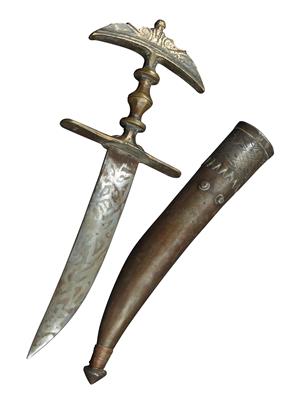Afghanistan, Nuristan: A typical Nuristani dagger.

Nuristan (‘Land of Light’) is a remote province in northeast Afghanistan. In three spacious valleys of the southern Hindu Kush mountains, an interesting alternative culture has continued to exist over many centuries: with its own religion, its own languages, as well its own clearly defined anthropological and cultural characteristics. As recently as 1896, Nuristan was forcibly ‘Islamised’ from Kabul. The present dagger is the typical weapon of the men of Old Nuristan (previously called ‘Kafiristan’, the ‘Land of the Infidels’): The slightly curved, double-edged iron blade is in this case etched with simple patterns. The hilt above it by is made of yellow cast-alloy (brass) and executed with ‘waste mould’ casting in characteristic Nuristani form. The wooden sheath is almost entirely enveloped with iron, as well as decorated with engraved, crossed lines, carved spikes, two added iron knops and a short copper wire-wrapping. The sheath terminates in a simple bud. Nuristani daggers are rare! 19th century to early 20th century; L: 40 cm. (ME)
Provenance: German private collection.
Esperto: Prof. Erwin Melchardt
 Prof. Erwin Melchardt
Prof. Erwin Melchardt
+43-1-515 60-465
erwin.melchardt@dorotheum.at
05.11.2014 - 13:00
- Prezzo realizzato: **
-
EUR 475,-
- Stima:
-
EUR 600,- a EUR 800,-
Afghanistan, Nuristan: A typical Nuristani dagger.
Nuristan (‘Land of Light’) is a remote province in northeast Afghanistan. In three spacious valleys of the southern Hindu Kush mountains, an interesting alternative culture has continued to exist over many centuries: with its own religion, its own languages, as well its own clearly defined anthropological and cultural characteristics. As recently as 1896, Nuristan was forcibly ‘Islamised’ from Kabul. The present dagger is the typical weapon of the men of Old Nuristan (previously called ‘Kafiristan’, the ‘Land of the Infidels’): The slightly curved, double-edged iron blade is in this case etched with simple patterns. The hilt above it by is made of yellow cast-alloy (brass) and executed with ‘waste mould’ casting in characteristic Nuristani form. The wooden sheath is almost entirely enveloped with iron, as well as decorated with engraved, crossed lines, carved spikes, two added iron knops and a short copper wire-wrapping. The sheath terminates in a simple bud. Nuristani daggers are rare! 19th century to early 20th century; L: 40 cm. (ME)
Provenance: German private collection.
Esperto: Prof. Erwin Melchardt
 Prof. Erwin Melchardt
Prof. Erwin Melchardt
+43-1-515 60-465
erwin.melchardt@dorotheum.at
|
Hotline dell'acquirente
lun-ven: 10.00 - 17.00
kundendienst@dorotheum.at +43 1 515 60 200 |
| Asta: | Tribal Art |
| Tipo d'asta: | Asta in sala |
| Data: | 05.11.2014 - 13:00 |
| Luogo dell'asta: | Wien | Palais Dorotheum |
| Esposizione: | 31.10. - 05.11.2014 |
** Prezzo d’acquisto comprensivo dei diritti d’asta acquirente e IVA
Non è più possibile effettuare un ordine di acquisto su Internet. L'asta è in preparazione o è già stata eseguita.
